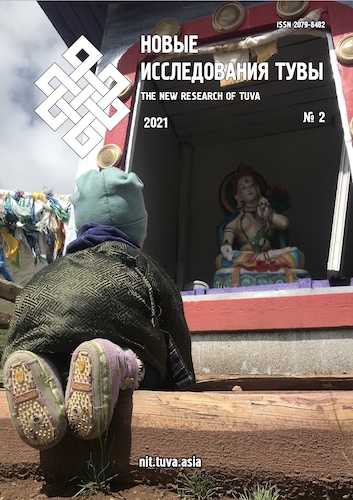Social Culture of Tuvans and Online Space
DOI:
https://doi.org/10.25178/nit.2021.2.10Keywords:
Tuvans; Tuva; social culture; space; understanding of space; worldview; social network; messaging app; kin groupAbstract
The article analyzes the issue of how modern technologies have become, among other things, a sort of vehicles of archaization for Tuvans, i.e. of the process of returning to archaic social and cultural ties and meanings. The source of the data is the author’s survey of Tuvans who use social networks and messaging apps. The survey was conducted in early 2021 by random sampling, covering 205 people who answered the questionnaire published on Google Forms.
Today Russian cyberethnography is more focused on studying the presentation of ethnicity on the Internet. The author suggests going further and considering the network as a new space for the functioning of an ethnic group’s social culture in the case of Tuvans. The analysis is based on the ideas of the anthropologists Ch. Hine and H. Rheingold. This allows us to talk about a network sociality as a fact of social reality.
The development of wireless Internet in Tuva has led to the same results as all over the globe — people have learned to act together in conditions that previously did not permit this. A significant number of Tuvans use chat groups (of relatives, colleagues, friends) in messaging apps, especially on Viber. Communication via them has various social “consequences”. Most often, Viber is used to communicate with friends and relatives (90.2%). The groups of relatives number from 13 to 70 people, communication in them is flowing almost constantly, typically in the Tuvan language; participants exchange information, news, and arrange collective actions. The use of web communications as a tool for unity and coordination of actions allows Tuvans to vote in online contests of various kinds as effectively as possible.
A historical insight allows us to see that the space of the social culture of Tuvans has undergone changes throughout history, and the social culture has preserved its basic values — the significance of social ties among kin groups.
References
Abramov, R. N. (2006) Mobil'nye kommunikatsionnye tekhnologii i povsednevnost'. Reingol'd G. Umnaia tolpa: novaia sotsial'naia revoliutsiia. M.: Fair-Press, 2006. — 416 s. [Mobile communicative technologies and everyday life. Howard Rheingold’s “Smart Mobs: The Next Social Revolution” (Moscow, Fair-Press, 2006. 416 p.)]. The Journal of Sociology and Social Anthropology, vol. 9, no. 4, pp. 185–192. (In Russ.).
Belorussova, S. Yu. and Golovnev A. V. (2019) Virtual'naia etnichnost' — novatsiia na fone traditsii? (Vvedenie v temu) [Is virtual ethnicity a novel phenomenon in the context of tradition? (Introduction to the special issue theme)]. Siberian Historical Research, no. 2, pp. 36–40. (In Russ.). DOI: https://doi.org/10.17223/2312461X/24/2
Byl'eva, D. S. and Lobatiuk, V. V. (2017) Smartmob: sotsial'no-filosofskii analiz [Smart mob: A socio-philosophical analysis]. Society. Communication. Education. Peter the Great St. Petersburg Polytechnic University, vol. 8, no. 4, pp. 96–107. (In Russ.). DOI: https://doi.org/10.18721/JHSS.8410
Vasil'ev, A. V., Korkiia, E. D. and Mamedov A. K. (2019) Kul'tura kommunikatsii v usloviiakh informatsionnoi globalizatsii [Culture of communications in the conditions of information globalization]. Moscow, Maks-Press. 160 p. (In Russ.).
Gabdrakhmanova, G. F. and Makhmutov, Z. A. (2018) Natsional'nyi internet Rossii: k postanovke problemy [National Internet of Russia: Problem statement revisited]. Oriental Studies, vol. 11, no. 3, pp. 142–151. (In Russ.). DOI: https://doi.org/10.22162/2619-0990-2018-37-3-142-151
Golovnev, A. V. (2018) Etnografiia v rossiiskoi akademicheskoi traditsii [Ethnography in the Russian academic tradition]. Etnografia, no. 1, pp. 6–39. DOI: https://doi.org/10.31250/2618-8600-2018-1-6-39
Golovnev, A. V. (2019) Kruzhenie v kochevom i virtual'nom prostranstve-vremeni [Circling in nomadic and virtual space-time]. Siberian Historical Research, no. 2, pp. 108–131. (In Russ.). DOI: https://doi.org/10.17223/2312461X/24/6
Golovnev, A. V., Belorussova, S. Yu. and Kisser, T. S. (2018) Veb-etnografiia i kiberetnichnost' [Web-ethnography and cyber-ethnicity]. Ural Historical Journal, issue 1, pp. 100–108. DOI: https://doi.org/10.30759/1728-9718-2018-1(58)-100-108
Dulov, V. I. (1956) Sotsial'no-ekonomicheskaia istoriia Tuvy. XIX — nachalo XX v. [The socio-economic history of Tuva. The 19th — early 20th centuries]. Moscow, Publ. House of the Academy of Sciences of the USSR. 608 p. (In Russ.).
Istoriia Tuvy [The history of Tuva] (2001) : in 2 vols. 2nd ed. / ed. by S. I. Vanshtein and M. Kh. Mannai-ool. Novosibirsk, Nauka. Vol. I. 367 p. (In Russ.).
Kisser, T. S. (2019) Virtual'naia identichnost' rossiiskikh nemtsev [The virtual identity of the Russian Germans]. Siberian Historical Research, no. 2, pp. 64–84. (In Russ.). DOI: https://doi.org/10.17223/2312461X/24/4
Kuzhuget, Sh. Yu., Suvandii, N. D., Dambaa, Sh. V. and Lamazhaa, Ch. K. (2019) Kontsept törel ‘rodstvennik’ v iazykovoi kartine mira tuvintsev [The concept of torel ('relative') in the Tuvan linguistic world picture]. New Research of Tuva, no. 3, pp. 149–157. (In Russ.). DOI: https://doi.org/10.25178/nit.2019.3.12
Lamazhaa, Ch. K. (2010) Klanovost' v politike regionov Rossii. Tuvinskie praviteli [The clan politics of Russia’s regions. The leaders of Tuva]. St. Petersburg, Aletheia. 208 p. (In Russ.).
Lamazhaa, Ch. K. (2011) Tuva mezhdu proshlym i budushchim [Tuva between the past and future]. St. Petersburg, Aletheia. 368 p. (In Russ.).
Lamazhaa, Ch. K. (2012) Arkhaizatsiia obshchestva. Tuvinskii fenomen [Archaization of the society. Tuvan phenomenon]. Moscow, Publ. House “Librokom”. 272 p. (In Russ.)
Lamazhaa, Ch. K. (2021) Tuvinskie obriady dagylga v XXI veke [Tuvan rites dagylga in the 21st century]. Etnograficheskoe obozrenie, no. 2, pp. 125–143. (In Russ.). DOI: https://doi.org/10.31857/S086954150014811-2
Mannai-ool, M. Kh. (2004) Tuvintsy: proiskhozhdenie i formirovanie tuvinskogo etnosa [Tuvans: The origin and formation of the Tuvan ethnos]. Novosibirsk, Nauka. 166 p. (In Russ.).
Mart'ianov, D. S. and Mart'ianova, N. A. (2012) Diskursivnye aspekty etnicheskoi identichnosti v internete [Discursive aspects of ethnic identity on the Internet]. Vestnik SGUTiKD, no. 2 (20), pp. 233–238. (In Russ.).
Makhmutov, Z. A. and Gabdrakhmanova, G. F. (2016) Osobennosti etnicheskoi identichnosti virtual'nykh tatarskikh soobshchestv v sotsial'noi seti VKontakte [Features of ethnic identity of Tatar virtual communities in the “VKontakte” social network]. Istoricheskaia etnologiia, vol. 1, no. 2, pp. 276–292. (In Russ.).
Ocherki sotsial'nogo razvitiia Tuvinskoi ASSR [Essays on social development of the Tuvan ASSR] (1983) / ed. by Yu. L. Aranchyn. Novosibirsk, Nauka. 262 p. (In Russ.).
Potapov, L. P. (1969) Ocherki narodnogo byta tuvintsev [The Tuvans: Sketches of the folk lifestyle and related household activities]. Moscow, Nauka, GRVL. 402 p. (In Russ.).
Rheingold, H. (2006) Umnaia tolpa: novaia sotsial'naia revoliutsiia [Smart mobs: The next social revolution] / transl. from Engl. Moscow, Fair-Press. 416 p. (In Russ.).
Rheingold, H. (2013) Pereosmysliaia fenomen virtual'nogo soobshchestva [Rethinking virtual communities]. Studia Culturae, no. 15, pp. 243–250. (In Russ.).
Smirnov, D. N. (2008) Politicheskoe manipulirovanie i tekhnologiia «umnykh tolp» kak sredstva bor'by za gegemoniiu [Political manipulation and smart mob technology as means of struggle for hegemony]. Izvestia: Herzen University Journal of Humanities & Sciences, no. 67, pp. 247–251. (In Russ.).
Sotsial'no-stratifikatsionnye protsessy v Respublike Tyva [Socio-stratification processes in the Republic of Tuva] (2020) / Z. T. Golenkova et al., ed. by Z. T. Golenkova, Yu. V. Goliusova and P. E. Sushko. Moscow ; Kyzyl, FCTAS RAS. 128 p. DOI: https://doi.org/10.19181/monogr.978-5-89697-332-4.2020
Stépanoff, Ch. (2009) Metamorfozy rodstva u tuvintsev [Metamorphoses of kinship among Tuvans]. Etnograficheskoe obozrenie, no. 4, pp. 129–145. (In Russ.).
Suleimanova, O. A. (2020) Prezentatsiia kul'tury kol'skikh saamov v sotsial'noi seti «Vkontakte»: dinamika vizual'nykh obrazov material'noi kul'tury [Presentation of the culture of the Kola Sami in VKontakte social network: The dynamics of the visual images of material culture]. Etnografia, no. 3, pp. 169–199. DOI: https://doi.org/10.31250/2618-8600-2020-3(9)-169-199
Traditsionnoe mirovozzrenie tiurkov Iuzhnoi Sibiri. Prostranstvo i vremia. Veshchnyi mir [The traditional worldview of Turkic peoples of South Siberia. Space and time. The material world] (1988) / E. L. L'vova, I. V. Oktiabr'skaia, A. M. Sagalaev and M. S. Usmanova. Novosibirsk, Nauka. 226 p. (In Russ.).
Castells, M. (1996) The rise of the network society. Cambridge, MA, Blackwell. 625 p.
Ethnography and virtual worlds: A handbook of method (2012) / T. Boellstorff, B. Nardi, C. Pearce, T. L. Taylor. Princeton ; Oxford, Princeton University Press. 264 p. DOI: https://doi.org/10.2307/j.cttq9s20
Hine, C. (2000) Virtual ethnography. London ; Thousand Oaks ; New Delhi, Sage Publications Ltd. 192 p.
Marcus, G. (2012) Foreword. In: Ethnography and virtual worlds: A handbook of method, by T. Boellstorff, B. Nardi, C. Pearce, T. L. Taylor. Princeton ; Oxford, Princeton University Press. Pp. XIII–XX. DOI: https://doi.org/10.2307/j.cttq9s20.4
Markham, A. N. (2013) Fieldwork in social media. What would Malinowski do? Qualitative Communication Research, vol. 2, no. 4, Winter, pp. 434–446. DOI: https://doi.org/10.1525/qcr.2013.2.4.434
Rheingold, H. (1993) The virtual community: Homesteading on the electronic frontier. Reading, MA, Addison-Wesley. 325 p.
Rheingold, H. (2000) The virtual community: Homesteading on the electronic frontier. 2nd ed. Cambridge, MA, MIT Press.
Rheingold, H. (2002) Smart mobs: The next social revolution. Cambridge, MA, Perseus Pub. 296 p.
Published
How to Cite
С. 115-129. DOI: https://www.doi.org/10.25178/nit.2021.2.10
For citation:
Lamazhaa Ch. K. Sotsial'naia kul'tura tuvintsev i onlain-prostranstvo [Social Culture of Tuvans and Online Space]. New
Research of Tuva, 2021, no. 2, pp. 115-129. (In Russ.). DOI: https://www.doi.org/10.25178/nit.2021.2.10
Issue
Section

This work is licensed under a Creative Commons Attribution-NonCommercial 4.0 International License.

Author(s) license holder(s) grant rights for their work to the journal (grantee of a license) under the simple non-exclusive open license in accordance with Art. 1286.1 «Open license for a research work, work of literature or fine arts», Civil Code of the Russian Federation.
New Research of Tuva publishes articles under the Creative Commons Attribution-NonCommercial license (CC BY-NC).
Since it is an open license, author(s) reserve the right to upload the article to their institutional repository, submit it to another journal (if it allows republications), or republish it on their own website (in full, or in part).
However, several conditions apply here:
a) The republished version must always contain the name(s) and affiliation(s) of the author(s), the original title and the hyperlink to the original version on the New Research of Tuva website;
b) It must be in open access, free of charge, and no category of readers must be in any way whatsoever advantaged over general readership.
c) should the contribution be submitted elsewhere by its author(s) without substantial modification (30% or more of original text unchanged), the body of the article should contain a disclaimer that the original version was published in New Research of Tuva (with a link to the respective page)
The CC-BY-NC is a non-revocable license which applies worldwide and lasts for the duration of the work’s copyright.









